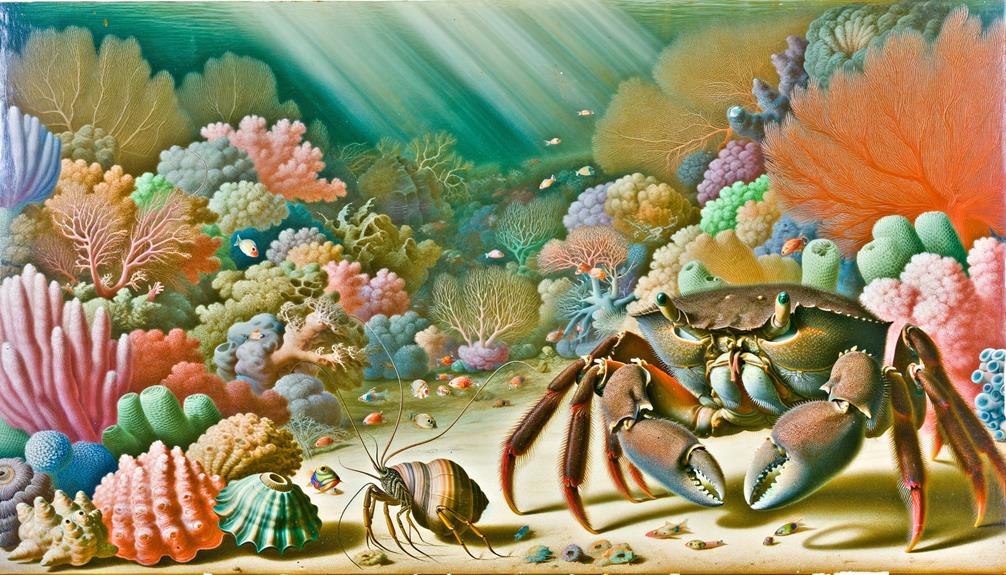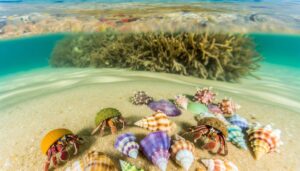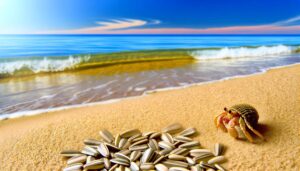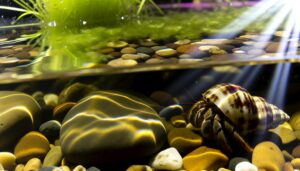Do Crabs Have Parental Care?
Yes, crabs do eat hermit crabs. In coastal environments, predatory crabs sometimes target smaller hermit crabs, extracting them from their protective shells.
Crabs are omnivores and opportunistic feeders, consuming various invertebrates, including hermit crabs when available. Hermit crabs employ defense mechanisms like shell selection and autotomy to avoid predation.
These species also compete for resources like food and shelter, leading to complex interactions. Environmental factors, such as habitat complexity and resource availability, play significant roles in their survival strategies.
Intrigued by these fascinating dynamics? Continue exploring to learn more about their intricate behaviors and adaptations.

Key Takeaways
- Predatory crabs do eat hermit crabs, often targeting smaller individuals.
- Crabs use tactics like ambush and shell extraction to capture hermit crabs.
- Hermit crabs employ defense mechanisms such as shell selection and autotomy to avoid predation.
- Complex predator-prey relationships exist between crabs and hermit crabs due to size and shell type.
- Crabs' predation on hermit crabs influences shell selection and survival strategies in hermit crabs.
Crab Species Overview
Crabs, belonging to the order Decapoda, exhibit a wide range of species with distinct morphological and behavioral traits. You'll find them in various habitats, from deep oceans to freshwater environments. Decapods have ten limbs, including pincers, which they use for feeding and defense. Their exoskeletons provide protection, while their gills facilitate underwater respiration.
Some species, like the Blue Crab (Callinectes sapidus), are known for their swimming capabilities, thanks to specially adapted hind legs. Others, like the Coconut Crab (Birgus latro), are primarily terrestrial. Crabs play essential roles in their ecosystems by controlling prey populations and recycling nutrients.
Understanding these diverse species is vital for conservation efforts, ensuring sustainable practices, and maintaining ecological balance.
Hermit Crab Characteristics
Hermit crabs, known for their unique adaptive behavior, occupy discarded shells for protection and mobility. You'll notice they've soft, vulnerable abdomens that require external shells for defense against predators and environmental hazards. Their exoskeletons cover only the front part of their bodies, necessitating the use of shells.
Hermit crabs exhibit:
- Molting: Periodically shedding their exoskeleton to grow.
- Shell Selection: Choosing and switching shells as they grow.
- Social Behavior: Interacting with other hermit crabs, particularly during shell exchanges.
Their antennae are highly sensitive, aiding in the detection of food and navigation. They possess both chelipeds (claws) and walking legs, with the larger claw used for defense and capturing food.
Understanding these characteristics helps you appreciate their survival strategies and ecological roles.
Natural Habitats
In their natural habitats, you'll find hermit crabs thriving in coastal regions, particularly in intertidal zones and shallow waters. These environments provide ample resources and protection for their daily activities. Hermit crabs often inhabit areas rich in sand, rocks, and tidal pools, which offer diverse food sources and suitable shelters.
| Feature | Description | Example Locations |
|---|---|---|
| Intertidal Zones | Areas between high and low tide | Mangrove swamps, beaches |
| Shallow Waters | Depths up to 200 meters | Coral reefs, seagrass beds |
| Sand | Fine, granular substrate | Sandy shores |
| Rocks | Hard, stable structures | Rocky coastlines |
These habitats ensure hermit crabs have access to the necessary resources for survival, from finding food to selecting best shells for protection.
Crab Feeding Habits
Understanding the diverse feeding habits of crabs provides insight into their ecological roles and interactions within marine ecosystems.
You'll find that crabs are generally omnivores, consuming a wide range of food sources. Their diet primarily consists of:
- Algae: Crabs often graze on various types of algae, contributing to the balance of marine plant life.
- Small Invertebrates: Crabs prey on organisms like mollusks, worms, and small crustaceans, maintaining population control.
- Detritus: By consuming decaying organic matter, crabs help recycle nutrients within the ecosystem.
These feeding behaviors highlight crabs' adaptability and their critical role in maintaining ecological equilibrium.
Hermit Crab Diet
While they often scavenge for food, hermit crabs primarily consume a variety of plant and animal materials, including algae, decaying wood, and small invertebrates. You'll find that their diet is quite diverse, allowing them to adapt to different environments.
Hermit crabs also benefit from consuming detritus, which helps recycle nutrients back into their ecosystem. They've specialized appendages, known as maxillipeds, to manipulate and ingest food efficiently.
It's crucial to provide a balanced diet if you're caring for them in captivity, including fresh vegetables, fruits, and protein sources. By understanding their dietary needs, you can secure their health and well-being, contributing to a more sustainable and thriving habitat for these fascinating creatures.
Predatory Behavior in Crabs
Shifting our focus from the diet of hermit crabs, it's important to examine the predatory behavior exhibited by various crab species.
Crabs are opportunistic predators that utilize a range of tactics to capture prey. You'll find that their predatory strategies are highly specialized and adapted to their environments.
- Ambush Predation: Crabs often hide and wait for unsuspecting prey to come close, then strike swiftly.
- Active Hunting: Some species actively pursue their prey, using their pincers to capture and subdue them.
- Scavenging: Crabs are also known to scavenge, feeding on dead or decaying organisms, including other crabs.
Understanding these behaviors helps you appreciate the complex interactions within marine ecosystems and the role crabs play in maintaining ecological balance.
Shell Protection Mechanism
You're probably aware that hermit crabs rely heavily on their shells for protection.
Hermit crabs meticulously choose shells that offer the best defense against predators, a process known as shell selection.
This shell not only acts as a physical barrier but also provides camouflage, reducing the risk of predation.
Shell Selection Process
When a hermit crab outgrows its current shell, it carefully searches for a new one that provides ideal protection and space for growth. This selection process is crucial for the hermit crab's survival and involves assessing various factors:
- Size: The shell must be roomy enough to accommodate future growth.
- Weight: It needs to be light enough for mobility yet sturdy for protection.
- Shape: The internal structure should fit the hermit crab's body snugly.
You'll notice that hermit crabs often inspect multiple shells, sometimes even engaging in shell exchanges with other crabs. The careful nature of this process ensures they choose a shell that maximizes their chances of survival and adaptability in their ever-changing environments.
Defense Against Predators
Once a hermit crab secures a suitable shell, it relies on this newfound home to protect against predators like fish, birds, and other crabs. The shell provides a robust exoskeleton, which minimizes vulnerability. When threatened, the hermit crab can retract entirely into the shell, sealing off the entrance with its hardened claws. This behavior, known as cheliped defense, reduces the chance of predation.
Moreover, some hermit crabs select shells that offer additional camouflage, blending seamlessly with their environment. Others may attach sea anemones to their shells, benefiting from the anemones' stinging cells as an extra layer of protection.
Observed Interactions
Field studies document various interactions between crabs and hermit crabs, highlighting instances of predation, competition, and cohabitation. You'll notice that these interactions can be quite complex, often driven by environmental conditions and resource availability.
- Predation: Larger crabs have been observed preying on hermit crabs, particularly when food is scarce.
- Competition: Both species may compete for resources such as food and shelter, especially in densely populated areas.
- Cohabitation: Sometimes, hermit crabs and other crabs coexist peacefully, particularly when resources are abundant and territory overlap is minimal.
These interactions underscore the dynamic nature of marine ecosystems, where survival often depends on adaptability and resourcefulness. Understanding these behaviors can help you better appreciate the intricate balance within these aquatic communities.
Studies and Research
You'll find that studies highlight predatory behavior patterns among various crab species, providing insights into their hunting techniques.
Researchers have also documented hermit crab defense mechanisms, which include shell selection and aggressive posturing.
These studies contribute to understanding the interactions and survival strategies within these marine communities.
Predatory Behavior Observations
Several studies have documented instances of crabs exhibiting predatory behavior toward hermit crabs, highlighting a complex ecological interaction. When observing these behaviors, researchers noted several key patterns:
- Ambush Tactics: Crabs often hide and wait for hermit crabs to come within striking distance.
- Shell Extraction: Some crabs have developed methods to extract hermit crabs from their protective shells.
- Feeding Preferences: Predatory crabs show a preference for smaller, more vulnerable hermit crabs.
These observations underline the dynamic predator-prey relationships within marine ecosystems.
You'll find that crabs, as opportunistic feeders, exploit various strategies to capture and consume hermit crabs. Understanding these interactions is essential for marine biologists and conservationists aiming to maintain balanced marine habitats.
Hermit Crab Defense Mechanisms
To counteract the predatory tactics of crabs, hermit crabs have developed a range of sophisticated defense mechanisms, which researchers have extensively documented. By utilizing their adaptive behaviors, hermit crabs enhance their survival chances.
| Defense Mechanism | Description | Research Findings |
|---|---|---|
| Shell Utilization | Hermit crabs select and modify shells for protection | Studies show increased survival with robust shells |
| Autotomy | Ability to shed limbs to escape predators | Documented in numerous crustacean species |
| Chemical Camouflage | Use of chemical cues to blend into the environment | Found to reduce predation rates significantly |
| Aggressive Displays | Exhibiting threatening behaviors to deter attackers | Observed to be effective in field studies |
These mechanisms demonstrate the hermit crab's evolutionary advancements in predator avoidance, highlighting the intricate balance between predator and prey within marine ecosystems.
Interspecies Competition
Interspecies competition between crabs and hermit crabs often revolves around the scarcity of suitable shells and limited food sources. When you observe these interactions, you'll notice that both species vie for resources essential to their survival.
This competition can manifest in several ways:
- Resource Allocation: Both crabs and hermit crabs compete for limited food, often leading to aggressive encounters.
- Habitat: Suitable shells are vital for hermit crabs, and their availability can greatly affect their well-being.
- Predation: Crabs may occasionally prey on hermit crabs, particularly if other food sources are scarce.
Understanding these dynamics helps you appreciate the delicate balance within marine ecosystems. Your awareness can guide conservation efforts, ensuring that both species thrive without undue stress.
Environmental Influences
Environmental factors like water temperature, salinity, and habitat complexity directly impact the interactions between crabs and hermit crabs. You need to understand how these elements influence their behavior and survival. For instance, higher water temperatures can increase metabolic rates, prompting crabs to hunt more aggressively. Salinity levels affect osmoregulation, impacting both species' physiological processes. Habitat complexity offers hiding spaces, reducing predation rates. The following table summarizes these influences:
| Factor | Impact on Crabs | Impact on Hermit Crabs |
|---|---|---|
| Water Temperature | Increased metabolism | Altered activity levels |
| Salinity | Osmoregulation stress | Physiological adaptation |
| Habitat Complexity | Enhanced hiding opportunities | Reduced predation risk |
Survival Strategies
To understand how hermit crabs survive potential predation, you'll examine their shell selection process, defense mechanisms, and predation avoidance tactics.
Each of these strategies enhances their chances of evading predators, including other crabs.
Shell Selection Process
While selecting a suitable shell, hermit crabs exhibit a meticulous process that greatly impacts their survival and growth. You'll notice that hermit crabs don't just pick any shell; they assess several factors to ensure prime protection and mobility.
Key considerations include:
- Size and Fit: The shell must accommodate their growing bodies without being too large or small.
- Structural Integrity: Crabs prefer shells that are intact and free from significant damage to avoid vulnerabilities.
- Weight: Lightweight shells are favored to enhance mobility and reduce energy expenditure.
This methodical selection is crucial for their sustenance, as an ill-fitting or damaged shell can make them susceptible to predators and environmental stressors. By prioritizing these factors, hermit crabs enhance their chances of long-term survival.
Defense Mechanisms Employed
Hermit crabs employ various defense mechanisms, such as retracting into their shells and using their claws for protection, to enhance their survival against predators. When threatened, a hermit crab will quickly withdraw into its shell, sealing the opening with its sturdy claws. This behavior minimizes exposure and creates a formidable barrier against potential attackers.
Additionally, hermit crabs can utilize their claws to grasp and fend off smaller predators. Their exoskeleton provides further protection, reducing vulnerability to physical attacks. These defense strategies are critical for evading numerous marine predators, including larger crabs.
Predation Avoidance Tactics
Beyond their immediate defense mechanisms, hermit crabs employ several predation avoidance tactics that enhance their long-term survival. You'll find these crustaceans adept at utilizing their environment and behavior to evade predators. Consider these strategies:
- Shell selection: Hermit crabs choose shells that provide the best protection, often opting for those with narrow openings that limit predator access.
- Nocturnal activity: By being more active at night, they reduce encounters with diurnal predators.
- Burrowing: Hermit crabs dig into the substrate to create shelters, making it harder for predators to find and reach them.
These tactics, combined with their defensive behaviors, ensure hermit crabs maintain an edge against predation, contributing to their overall survival in diverse marine ecosystems.
Conclusion
In the grand theater of the ocean, think of crabs as cunning hunters and hermit crabs as cautious wanderers. You'll find that while some crabs do prey on hermit crabs, it's not a universal rule.
Environmental factors and available resources often dictate these interactions. Just as in any ecosystem, survival strategies and competition for limited resources play essential roles.
Understanding these dynamics helps reveal the intricate dance of life beneath the waves.






